BY TERRENCE RAFFERTY
Photographed by Henry Leutwyler
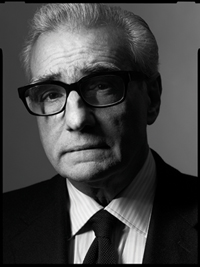 Talking with Martin Scorsese is a little like riding a roller coaster: the one on Coney Island, of course, because Scorsese is in every fiber of his being a New Yorker. The conversation goes up and down, changes speed and direction unpredictably, and you have to just strap yourself in and hang on.
Talking with Martin Scorsese is a little like riding a roller coaster: the one on Coney Island, of course, because Scorsese is in every fiber of his being a New Yorker. The conversation goes up and down, changes speed and direction unpredictably, and you have to just strap yourself in and hang on.
I spoke with him at his office in the DGA building on West 57th Street. It was about nine months after his work on his 21st feature, The Departed, had earned him his first Oscar for best director (on his sixth nomination) and his first Directors Guild Award (on his seventh nomination), and just two days after his 65th birthday. Despite having reached that milestone, he is obviously—and, for moviegoers, fortunately—not contemplating retirement anytime soon. He recently completed his Rolling Stones concert film, Shine a Light, and on the afternoon we met he was, he said, in the middle of casting a new movie that’s scheduled to start shooting next March. (He was, at that point, cagy about the details of this project.)
But for whatever reason, whether the big birthday was on his mind or not, his stream-of-consciousness discourse kept returning to the past: to his youth in Little Italy, and to the history of the art he practices and loves. It seemed appropriate, somehow, that we were sitting in his comfortably appointed, 13-seat screening room: I felt as if, given half a chance, he’d start firing up clips from the dozens of films he cited as we talked. Old movies and the old neighborhood have always been the default setting for Scorsese’s conversational style, but I thought I detected a certain slight wistfulness that hadn’t been present when I interviewed him a couple of decades ago. We began by talking about a short commercial film he had just finished shooting, whose subject—which tickled him enormously—was the possibility of absorbing the entire history of the movies into oneself.
TERRENCY RAFFERTY: What have you been working on lately?
MARTIN SCORSESE: Actually, I just got back from shooting a little industrial film for a Spanish sparkling wine, a three-week shoot. It’s about loving cinema so much you want to possess it completely—cinemania, cinemania.
Q: Something you probably know a little bit about.
A: Something I know about. But this is about something that’s ultimately unattainable, and that is to possess, to really possess in yourself all the time, the extraordinary feelings created in you by the films you love. The idea came from a writer named Ted Griffin, who borrowed it from the Borges story Pierre Menard, Author of the Quixote, in which the character tries to become Cervantes so he can write, from scratch, one chapter of Don Quixote. In our little movie we pretended we found two pages of a Hitchcock script that was never made and then we try to make the whole film—and it’s a grueling exercise.
Q: So the joke is you’re trying literally to be Hitchcock?
A: Which you can’t do, no way. We use CGI, and there’s a scene in which we try to recreate the imperfection of Jimmy Stewart falling out the window in Rear Window, and you can’t quite do it. If you look at that scene in Rear Window, when he’s hanging from the ledge and the people in the apartment run out to see what’s going on, they’re all skip-framed and they’re all moving very jerkily. And when he does fall, it looks very artificial but it’s totally disorienting. I’m not sure Hitchcock even meant it to look good. [laughs] We tried to do something like it, and we kept saying, ‘That’s awful, that’s wonderful.’ All put together, it’s a really disquieting effect.
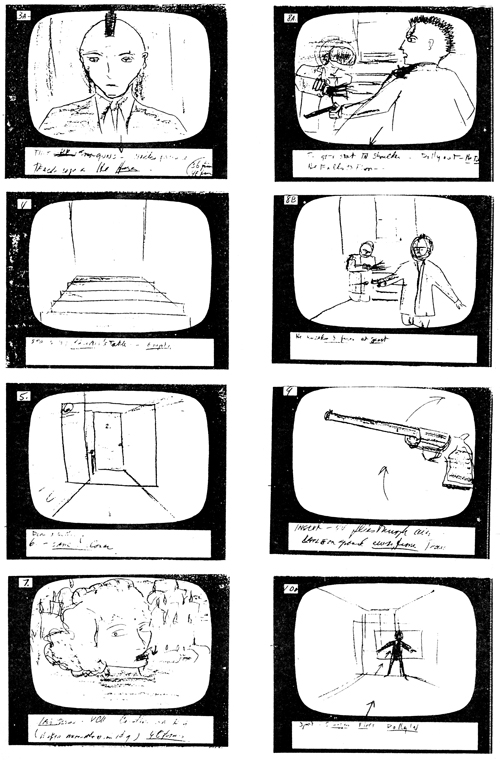 PICTURE THIS: Scorsese drew these storyboards for the bloody climax
PICTURE THIS: Scorsese drew these storyboards for the bloody climax
of Taxi Driver. (Photo Credit: Columbia Pictures/Photofest)Q: In general—if you can even analyze this—how do you use the example of the great films and great directors of the past?
A: It’s not always very specific. For example, for Taxi Driver, I screened Francesco Rosi’s Salvatore Giuliano, just because of the look of it, the tough, objective nature of his framing. There’s something uncompromising about that framing and also about his narrative style, and I suppose there’s also a bloodline thing because I’m Sicilian. I watch it once a year. It’s about coming from that part of the world and feeling that you have a destiny you can’t avoid—and that’s the connection to Travis Bickle, I think. And the black-and-white photography is so beautiful; it creates a landscape in which these extraordinary things can happen and in which it can be this way. And that’s what I wanted in color in Taxi Driver.
And I was also thinking about Jack Hazan’s movie A Bigger Splash about David Hockney. Again, there was just something about the way the images were framed, something very objective, a lot of head-on shots, which influenced the way I shot Travis’ cab pulling up to the grocery store before his first murder—it’s meant to look like a newspaper photo, to have the objectivity of a Weegee photo. And Hitchcock’s The Wrong Man...
Q: Why The Wrong Man?
A: Well, in that case it’s the camera moves, the small ones, all these insinuating, slow moves that look as if the camera itself were paranoid. I screened that movie again for The Aviator, because the way Hitchcock used inserts seemed to have something to do with the obsessive-compulsive thing I was dealing with in the Howard Hughes character. There’s a scene of Henry Fonda in his jail cell and there are inserts of the ceiling and the sink, and you can’t quite tell whether they’re from Fonda’s point of view, or they’re something else. The inserts in a Bresson picture like Pickpocket or Mouchette have that kind of impact, too, but I don’t know why, I can’t analyze it. When you ask how I relate to old movies and great directors, I’d say it’s more a matter of mood and impressions than anything else.
Q: So the idea is to recapture the original emotions these movies created in you?
A: That’s it. That’s it.
Q: ...and then analyze how they did it.
A: Yes, and that’s what I thought was so funny in the industrial I just did.
Q: When did you first become aware that movies had directors?
A: That’s different from becoming aware of the power of film, which I think began for me when I saw Duel in the Sun when I was 5 or 6 years old. But my awareness of directors probably started with John Ford. When I was a kid, in the late ’40s, I had severe asthma, and I wasn’t able to go outdoors that much, so the films that appealed to me most were the Westerns. For me there was a magic quality to them because of all that open space. And the animals. Because I wasn’t allowed to go near any animal, I loved movies with horses in them. When I grew up, I rode once. That was enough. But there was something about the Western that opened up my mind, took me to another world. And at that time, too, of course, there were the films noirs. They were captivating. You’re 7 years old, you go to the movies, and it’s Out of the Past!
Q: Were you already thinking about making movies?
A: No, they were mostly a world I could escape into. But in a way I was making them, because I was drawing pictures and putting them in frames like comic strips, telling stories that way. It was a great period to be growing up at the movies, from 1945 to 1960. You’d go from Out of the Past to Fort Apache—which is my favorite of Ford’s cavalry trilogy—to Sunset Boulevard to The Bad and the Beautiful.
Q: When do you think you really started to analyze how movies are directed?
A: Maybe when I was 13, 14, 15 years old. Around the time I saw The Searchers. And at about the same time I saw Citizen Kane on television, and The Third Man, and those movies made me very, very aware of style. I mean, I was obviously aware of style before that, but it was that seamless classic style of Ford and Wyler and Billy Wilder, and this didn’t feel the same. I started to realize that directing wasn’t just guiding an actor through a performance and choosing a nice place to put the camera. And Citizen Kane and The Third Man created in me emotions that seemed very, very different from the ones I had when I was watching the classical cinema, and that’s when I started trying to figure out why.
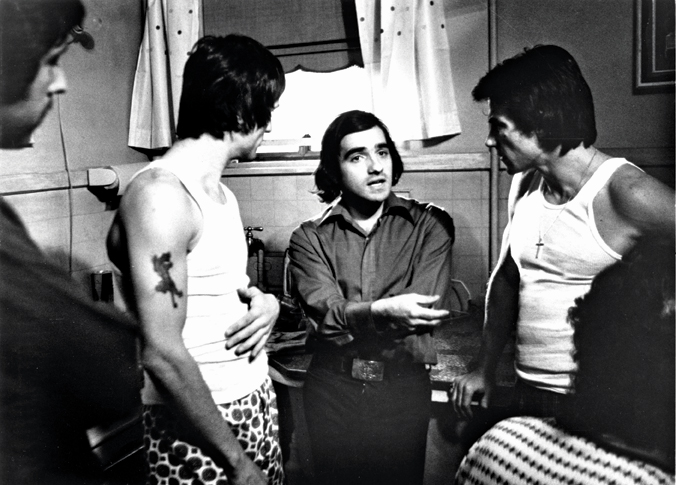 Scorsese works on a scene from Mean Streets with his
Scorsese works on a scene from Mean Streets with his
frequent collaborators Robert De Niro and Harvey Keitel.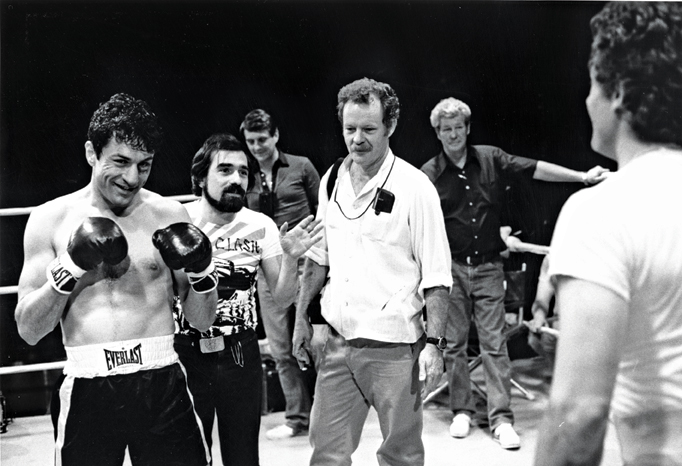 Scorsese goes a few rounds with Robert De Niro in Raging Bull.
Scorsese goes a few rounds with Robert De Niro in Raging Bull.
(Photo Credits: Warner Bros./United Artists/Photofest)Q: And what did you come up with?
A: The first thing I thought of was the different lenses, and then I thought about camera placement, and then lighting. But lighting has always eluded me; I don’t quite get it. Maybe because I never went to the theatre, or maybe because growing up in tenements I didn’t actually see much light—it was always dark.
Q: Lighting eludes you?
A: It was something I had to really learn, and even now I still need people to help me with it, because I don’t quite know how to express emotion, to bring out the psychological aspects of a character, with lighting. Most of my ideas about it were formed by the movies I saw between 1945 and 1960. Though when I became a film student in the early ’60s, we were all thinking about natural light, trying to emulate [cinematographers] Henri Decaë, Peter Suschitzky, John Alcott, the great Geoffrey Unsworth, with bounced light, indirect light—all that kind of stuff. Obviously, it was more practical for us to go that way, with quote-unquote indirect lighting, than studio lighting, because we had no studios. They tried to teach studio lighting at NYU, gave us John Alton’s Painting with Light. It’s a great book, but you kept thinking, this isn’t a movie studio, this is New York.
Q: But even before you went to film school you were studying films in your own way.
A: Well, after a certain point I was trying to analyze why I felt a particular way when I saw a particular film. I’d follow the films I liked, I’d stalk them—track down Citizen Kane on a rerelease double-bill with The Informer, that sort of thing. And watch them over and over on TV, though that’s obviously not the best way. I saw Ophüls’ Letter from an Unknown Woman all the time, and Jean Renoir’s Diary of a Chambermaid, which I was kind of obsessed with.
Q: No, it’s not the best way, but maybe you focus on different aspects of films when you watch them on TV—the narrative structure, the acting...
A: Yeah, good point. That’s probably why Lean’s Great Expectations looks so good on television. Dickens knew something about constructing a story.
Q: Just to get back to the present day for a minute, how did you feel about finally winning the Academy Award and the DGA Award, after so many nominations?
A: The word I’ve been using all year is “surprised.” I had no expectation that The Departed would be received the way it was by the Academy and the members of the Guild and all the critics’ groups that gave it a nod. I thought I was making a little genre movie. I tried to make a genre movie and I found out I couldn’t, that it became something else. How can you make a quote-unquote B film today? I guess you can, but I think you have to be younger, more up to date, more aware of how the world works right now. I’m very much of the past. My cellphone is beeping and I think I can get messages, but that’s about it. I don’t know how to use a computer. I know enough to know that I cannot make a real genre film, let’s say a noir. The impulse is there, but in the making of the picture—when I start working with the writer and the actors, it takes on a different kind of life, and I can’t just do a stylistic exercise anymore.
I mean, I love noir. The black-and-white look of Phil Karlson’s Kansas City Confidential or The Phenix City Story or Fuller’s Pickup on South Street, they can inspire me, and I like the sort of characters you get in noir, too. They’re doomed. They start out doomed, they know they’re doomed, and they end up doomed. [laughs] But to translate it to the world of today, as experienced by me—because that’s the only way I can address it—that’s something else. I don’t know if you can do such a thing, become the Hitchcock film, become Out of the Past—and that’s a picture I’ve always lived with, that I’ve never forgotten since I saw it as a kid: the darkness of the rooms, the raincoats. I was just hoping that people would see The Departed as a good entertainment.
Q: Which it is.
A: Yeah, but it also became something about this figure of the father who is powerful, all-powerful, but can’t be satiated, with anything: he needs the most violence, the most sex, the most drugs, nothing satisfies him. Anyway, the DGA Award was very special, because you know it’s your peers, whose work you respect so much. When I was making the movie, I was always invoking other directors, sort of calling on the spirits of Don Siegel and Anthony Mann and Sam Fuller: Where are you, come and help me! [laughs]
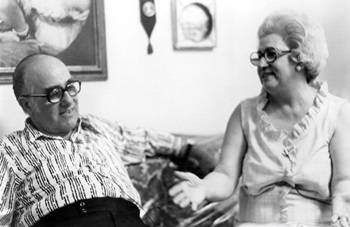 MEET THE FOLKS: The directors' parents Charles and Catherine in the
MEET THE FOLKS: The directors' parents Charles and Catherine in the
documentary Italianamerican. (Credit: National Communications Foundation) Q: Did having a less familiar location, Boston, give you extra stimulation for The Departed?
A: No, not really, because I was in the same place—I was in a bar. I used to say on the set, ‘What am I doing here? I did this picture already, I did it three years ago, I did it in GoodFellas, I did it in Mean Streets, I’m shooting in the same place. What am I doing?’ I was trying to make people laugh, because making a movie can be a stressful, physically demanding thing to do. But it’s OK. A bar is a whole world, so much happens in places like that. I was very aware of that when I was growing up—the neighborhood politics being conducted in the bars, the powerful people holding court there. It was like the Westerns.
Q: And you’re following up The Departed with a concert documentary about the Rolling Stones. Is Shine a Light finished?
A: Just finished. Like The Last Waltz, it’s an attempt to capture the nature of performance. I’d worked with Mick Jagger on a few things over the years, and I’d gone to a few Rolling Stones shows. He’d suggested my shooting one of their tour shows, but I thought I wouldn’t be able to add much to one of those big spectacles, so I suggested doing something in a smaller venue. And the band agreed.
Q: When you made The Last Waltz 30 years ago, there couldn’t have been many classic concert movies for you to screen.
A: One. Bert Stern’s Jazz on a Summer’s Day, about the 1958 Newport Jazz Festival, that’s the essential one. I screened it for the Rolling Stones film, too. Filming the Stones was different from filming The Band in The Last Waltz, though. The Band was in specific areas of the stage, they didn’t move very much, and, in a way, the most interesting action was the interplay of their vocals. Levon Helm sang, and Rick Danko, and Richard Manuel—sometimes Robbie Robertson, but mostly those three—and you’d watch these people becoming the same voice, the same person, in the song. With the Rolling Stones, it’s something else. I love the Stones, and I loved the process of designing shots to capture them. But no matter what we’d planned, the way they perform is—unpredictable. The issue became where to put all the cameras so we’d be sure to capture everything, so if one operator lost the action, there’d be another camera in the right place to pick it up. The filming was pretty intense. When it was over, it felt as if about a minute had gone by.
Q: Let’s talk about documentaries. You made them early in your career, and you’ve continued to make them ever since, which is unusual. Louis Malle did, and Jonathan Demme does that now, and Michael Apted, but not many others, really.
A: I came out of Washington Square College at NYU, and in the New York film world, the kind of films that were made were usually documentaries, or independent low-budget narrative films like Blast of Silence or Little Fugitive.
There was Cassavetes’ Shadows, and Kubrick’s Killer’s Kiss, Shirley Clarke’s films, and they all had elements of documentary. And it seemed that the technology we had available lent itself to documentary anyway. That’s what was nurtured at NYU by Haig Manoogian. He was also nurturing narrative films, but narrative films that came out of neorealism and the French New Wave. So it just seemed natural to me to pick up a camera like an Arriflex 16 mm and go out and shoot. And the nature of the way people related to each other in some of the Italian films, the Rossellini movies like Paisan or Fellini’s I Vitelloni, was like how the people related in the world I came from, so it felt right to put that kind of camera in that kind of world. No matter how many Westerns I liked, whenever I went to make a film it would have elements of documentary, like the neorealist films. And I sometimes feel that there’s something about the way documentary captures the nature of people that you can’t create any other way.
Q: Do you think making documentaries has had a strong effect on your narrative films?
A: In some ways, the picture I’ve directed that I learned the most from—and maybe I’ve been trying to unlearn it ever since—was Italianamerican, the movie about my mother and father. The camera stayed pretty still, and we simply asked a very few questions and they took off. They’d been married 42 years at that point, and I learned a lot about them I didn’t know in the two days I filmed them. Not just stories about the old days, but the way they related to each other, the way they spoke to one another. I mean, I’d heard it all my life, but not in this constructed way. It was a great revelation, and ultimately, I think, it influenced how I did certain scenes in Raging Bull and Taxi Driver.
The Rossellini films, especially Paisan and Voyage in Italy, were very important to me. There was a truthfulness in them about things and people I recognized. That was my universe, those were my aunts and my uncles and my parents. It was all, seemingly, documentary style, though it was staged, and in a way I’ve never gotten past that. I always feel that if I can, at times, get something on film that has the truthfulness and power that seem to come from the documentary—to me that’s the ultimate quest, really.
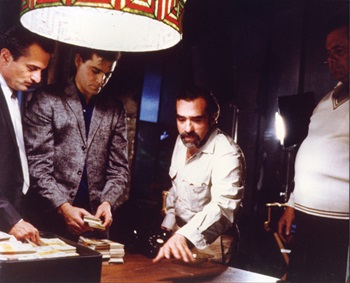 Scorsese (center) with Robert DeNiro, Ray Liotta and Paul Sorvino in GoodFellas.
Scorsese (center) with Robert DeNiro, Ray Liotta and Paul Sorvino in GoodFellas. 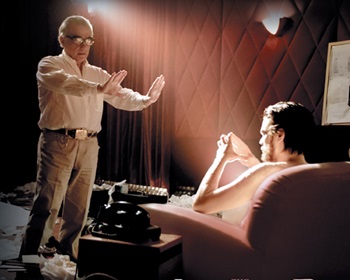 Scorsese directs Leonardo DiCaprio as Howard Hughes in
Scorsese directs Leonardo DiCaprio as Howard Hughes in
The Aviator. (Credits: Photofest; DGA Archives) Q: And does that documentary background have an effect on the way you approach acting in your movies, too?
A: Sure. There’s an element of documentary in The Departed, even though it’s at times a very rigorously written script. There’s a scene I like a lot between Jack Nicholson and Leonardo DiCaprio in which I really wanted there to be a kind of improvisation. I wanted an element of documentary-like surprise in the relationship between Jack and Leo, so I had to allow them a certain freedom—within the framework of the written dialogue and the basic structure of the scene. Jack was in a perfect position to do it, because he’s playing a king, a man who’s got all the power. So Leo’s character, who’s doomed from the beginning and who’s completely trapped in Jack’s world, sits down and Jack starts sniffing, saying, ‘I smell a rat.’ I can’t imagine what Leo must be feeling at this point as an actor, as the scene’s starting to go in this unexpected direction, not the way it was written. And the door to the room is locked.
If you look at the scene again, you see on Leo’s face that he wasn’t really aware of what was going to happen. His character is a subordinate, he can’t say anything, he can’t speak up. And Leo the actor is being kept off guard by Jack’s rearranging of dialogue in the scene, and then Jack pulls out a gun and he has no idea what’s going to happen and I don’t either—is Jack going to fire it next to his ear, shoot at the ceiling, what? So when you see Leo’s face in that scene, it’s very real. He doesn’t know what Jack’s going to do, he can’t leave the frame, he can’t run—he’s Leo DiCaprio and that’s Jack Nicholson and he’s got to sit there. [huge laugh] So the scene is also about who Jack is in Hollywood, and what he represents in Hollywood history, and who Leo is, and you play with that: Let’s see if there’s a changing of the guard here; let’s see how Leo and Jack work it out together.
Q: Let’s talk about acting, which is in some way the most neglected aspect of the director’s craft, just, I think, because the nature of acting is so much harder to pin down than visual style or editing technique or any of the other technical aspects of film. How did you learn to work with actors, or is that even something that can be learned?
A: I don’t know. I watched people in my neighborhood, I listened to my father tell stories. He and my mother both had good senses of humor and great timing. It was a fatalistic kind of humor that may be Mediterranean—the absurdity of life, this is the way life goes, that sort of point of view. That kind of humor was very much at odds with what I was learning in school, the American Dream and all that. Fatalistic humor—very funny, but with a very powerful seriousness at the core.
And like Henry Hill in GoodFellas, the street-corner guys in my neighborhood were always telling stories, often with themselves as the butt because they knew they could handle themselves, could take a punch if they had to. It was acting. It was all bravado, all swagger. I recognized that sort of acting in the Ford films, for example in the breakfast scene in The Searchers, the way Ward Bond moves around. That was the way people I knew walked, and there it was on the screen. When I saw On the Waterfront in 1954, there didn’t seem to be that much difference between what was on the screen and what was on the street. It didn’t seem like there was a camera at all, and then I knew I was free to dream that way—to try to get acting like that if I ever made a film.
Then there was Cassavetes’ Shadows, and the real clue there was the possibility of collaborating with actors who understood the world you came from. So the personal relationships with actors became very important to me, first with Harvey Keitel, and of course De Niro.
Q: Was there a lot of improvisation in your early films?
A: In Mean Streets, we improvised in rehearsals and then typed the scenes up, and rehearsed again, and the scene would evolve in that way. But it’s all really in the casting, ultimately. There’s something about what Cassavetes did with actors, there’s, I don’t know, just a love of being with actors, a love of seeing the actors becoming the characters they’re playing. And I do love that. Actors constantly surprise me, and I feel privileged to think that this performance by Keitel or De Niro or Ellen Burstyn is in my film. I’ll see something that happens on the set or look at the rushes and say to myself, this is why I do this.
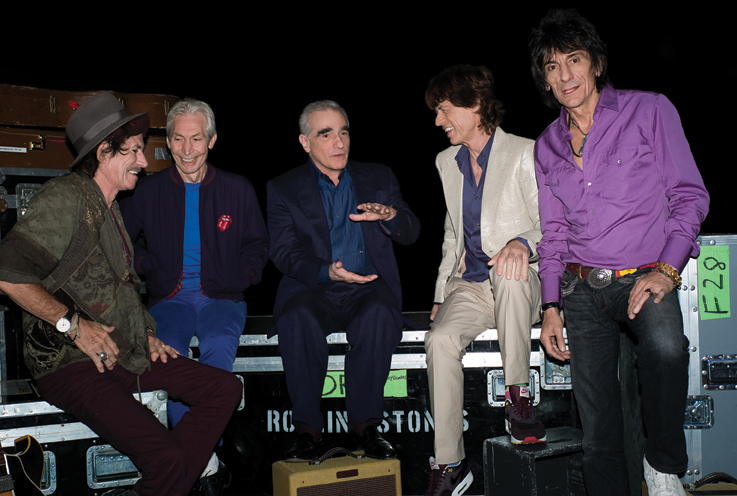 Scorsese with The Rolling Stones for the documentary Shine a Light.
Scorsese with The Rolling Stones for the documentary Shine a Light.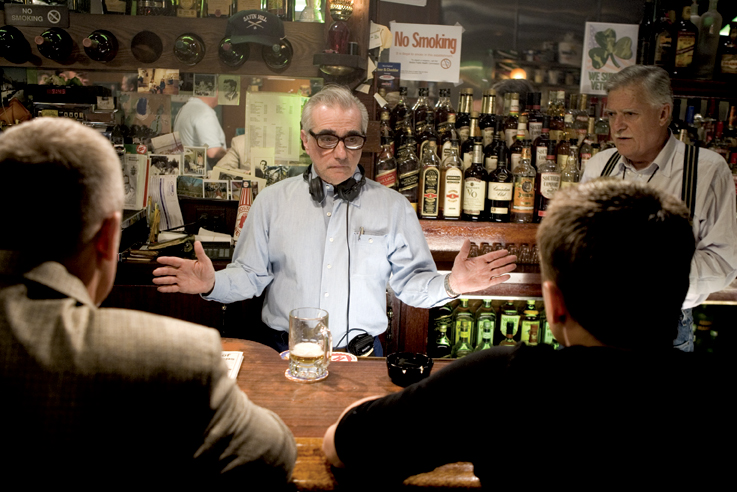 Scorsese serves up directorial advice to Leonardo DiCaprio in The Departed.
Scorsese serves up directorial advice to Leonardo DiCaprio in The Departed.
(Photo Credits: (top) Brigitte Lacombe; (bottom) Warner Bros.)Q: From the human to the technical: What do you think about the changes in movie technology over the years you’ve been making films?
A: It’s a different language now.
Q: What about the new technology has worked best for you?
A: The editing, that’s a little easier, and projecting the rushes on digital video. I’m looking forward to shooting with digital cameras, but I miss the celluloid—there’s no doubt about it. I miss the feeling of it, looking at the movie one frame at a time.
Q: When I first interviewed you and your editor, Thelma Schoonmaker, 20-some years ago, you were editing on...
A: The KEM, yeah. There was something about looking at the frame and knowing you could go inside that frame at that moment, right there. I miss that. It unnerves me to watch the editing machine going in fast forward or reverse, because nothing comes up in real time, it comes up in snatches of images and that confuses me. But it is faster, there’s no doubt. And the reality is that you always have to use the technologies that are around at the time.
Q: How about CGI?
A: Of course there were a lot of CGI shots in The Aviator, but they were designed in an old-fashioned way, from storyboards. In The Departed we used some digital effects to change backgrounds a little bit, change the lighting a bit here and there. Certain blood effects are good, too; not having to use squibs can save time in shooting. Shooting the film, that is. I’m still learning how to use CGI effects. The most I’ve used, I think, is in this little industrial we just shot in homage to Hitchcock, trying to recreate the old effects from 1955 with the newer technology.
But really it’s for other people to decipher, younger filmmakers or moving-image makers or whatever we’re going to call them in the future. It’s past me now. Cinema is finished, celluloid is finished.
Q: I know you’ve been a longtime advocate for film preservation—getting the studios to shift to safety stock in the early ’80s, creating The Film Foundation with the Guild in the early ’90s and funding the restoration of countless titles. What do you think are the current challenges in that field?
A: At this point, you say “film preservation and restoration” and people are going to know what you’re talking about. But there are still titles in serious need of help, preservation needs to become even more standardized than it is now. I think the more pressing issue right now is that people are starting to realize how vulnerable digital material is. A few years ago, it seemed to many people that digital was the magic bullet, the answer to everything: editing, color-correcting, and ultimately, I suppose, exhibition. But the digital formats aren’t as problem-free as they appeared to be in the first blush of enthusiasm. I recently heard of a major studio production, made within the last few years, whose elements had just blanked—the information didn’t hold, the ones and the zeroes. And that’s with a studio production.
So now the thinking is that the elements will have to migrate regularly from one format to the next. But that’s time-consuming and costly—and who’s going to do it? And what about low-budget independent productions? The problem is that everyone wants the problem to take care of itself, and it won’t. Films need constant maintenance, just like paintings. In terms of older films, you have to hold on to the original elements. If a film is shot on film, it should be preserved on film. Film is tried and true—we have films that have been around for over 100 years, but we still don’t know how long-term a solution digital is for storage and access. That said, digital is an amazing tool for archivists and preservationists. The bottom line is that film preservation is an on-going and evolving process. When you see the results onscreen with an audience, you realize it’s worth all the effort.
Q: So celluloid isn’t quite dead yet.
A: No. Celluloid’s still there. And right now the only way to have an element that means anything is to make separation negatives.
Q: And movies do have a future...
A: Yes, I guess they do, for now, anyway.
Q: Thanks for your time.
A: I’m screening The Seventh Victim—you know, the Val Lewton movie, directed by Mark Robson, 1943—a little later. Can you stay?